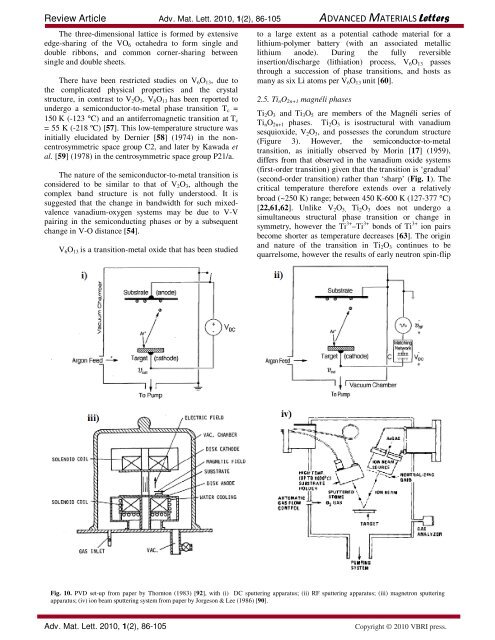Solid state thermochromic materials - Advanced Materials Letters
Solid state thermochromic materials - Advanced Materials Letters
Solid state thermochromic materials - Advanced Materials Letters
Create successful ePaper yourself
Turn your PDF publications into a flip-book with our unique Google optimized e-Paper software.
Review Article Adv. Mat. Lett. 2010, 1(2), 86-105 ADVANCED MATERIALS <strong>Letters</strong><br />
The three-dimensional lattice is formed by extensive<br />
edge-sharing of the VO6 octahedra to form single and<br />
double ribbons, and common corner-sharing between<br />
single and double sheets.<br />
There have been restricted studies on V6O13, due to<br />
the complicated physical properties and the crystal<br />
structure, in contrast to V2O3. V6O13 has been reported to<br />
undergo a semiconductor-to-metal phase transition Tc =<br />
150 K (-123 °C) and an antiferromagnetic transition at Tc<br />
= 55 K (-218 ºC) [57]. This low-temperature structure was<br />
initially elucidated by Dernier [58] (1974) in the noncentrosymmetric<br />
space group C2, and later by Kawada et<br />
al. [59] (1978) in the centrosymmetric space group P21/a.<br />
The nature of the semiconductor-to-metal transition is<br />
considered to be similar to that of V2O3, although the<br />
complex band structure is not fully understood. It is<br />
suggested that the change in bandwidth for such mixedvalence<br />
vanadium-oxygen systems may be due to V-V<br />
pairing in the semiconducting phases or by a subsequent<br />
change in V-O distance [54].<br />
V6O13 is a transition-metal oxide that has been studied<br />
to a large extent as a potential cathode material for a<br />
lithium-polymer battery (with an associated metallic<br />
lithium anode). During the fully reversible<br />
insertion/discharge (lithiation) process, V6O13 passes<br />
through a succession of phase transitions, and hosts as<br />
many as six Li atoms per V6O13 unit [60].<br />
2.5. TinO2n+1 magnéli phases<br />
Ti2O3 and Ti3O5 are members of the Magnéli series of<br />
TinO2n+1 phases. Ti2O3 is isostructural with vanadium<br />
sesquioxide, V2O3, and possesses the corundum structure<br />
(Figure 3). However, the semiconductor-to-metal<br />
transition, as initially observed by Morin [17] (1959),<br />
differs from that observed in the vanadium oxide systems<br />
(first-order transition) given that the transition is ‘gradual’<br />
(second-order transition) rather than ‘sharp’ (Fig. 1). The<br />
critical temperature therefore extends over a relatively<br />
broad (~250 K) range; between 450 K-600 K (127-377 °C)<br />
[22,61,62]. Unlike V2O3, Ti2O3 does not undergo a<br />
simultaneous structural phase transition or change in<br />
symmetry, however the Ti 3+ –Ti 3+ bonds of Ti 3+ ion pairs<br />
become shorter as temperature decreases [63]. The origin<br />
and nature of the transition in Ti2O3 continues to be<br />
quarrelsome, however the results of early neutron spin-flip<br />
Fig. 10. PVD set-up from paper by Thornton (1983) [92], with (i) DC sputtering apparatus; (ii) RF sputtering apparatus; (iii) magnetron sputtering<br />
apparatus; (iv) ion beam sputtering system from paper by Jorgeson & Lee (1986) [90].<br />
Adv. Mat. Lett. 2010, 1(2), 86-105 Copyright © 2010 VBRI press.
















